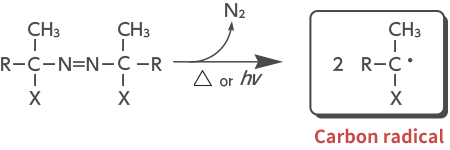Application examples of Azo initiators
Azo polymerization initiators are used as catalysts and foaming agents in organic processes, in addition to in polymer synthesis.

Polymer Synthesis
Radical polymerization of styrene

Radical polymerization of acrylic ester

Copolymerization of styrene and acrylic ester

Catalyst for Organic Synthesis
Addition reaction to olefins
Azo polymerization initiators can be used for addition reactions of HBr, H2S, etc. to olefins. Especially, when using styrenes, bromine or mercapto groups may be selectively introduced to the β position.

Mitsunobu reaction※1
Azo compounds※2 can be used as reagents for the Mitsunobu reaction.

※2 Azo compounds: Bis (2-methoxyethl) azodicarboxylate, etc.
Foaming Agent
Azo polymerization initiators are used as foaming agents for vinyl chloride (PVC) or other plastics, taking advantage of the property of generating nitrogen gas.
The "Azo Polymerization Initiator Decomposition Simulator" allows you to easily visualize the decomposition of azo polymerization initiators in a graph. You can use all 15 types of azo initiators, helping you select the best initiator for your polymerization conditions and optimize your polymerization process.


